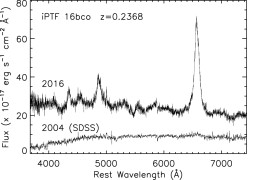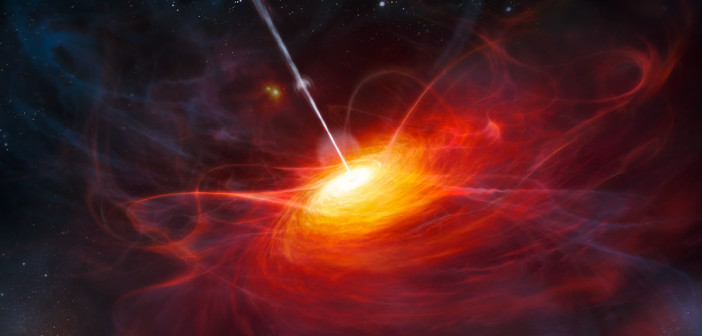The intermediate Palomar Transient Factory (iPTF) has discovered a quasar — the brightly-shining, active nucleus of a galaxy — abruptly turning on in what appears to be the fastest such transition ever seen in such an object.
A Rapid Transition
Quasars are expected to show variations in brightness on timescales of hours to millions of years, but it’s not often that we get to study their major variability in real time! So far, we’ve discovered only a dozen “changing-look” quasars — active galactic nuclei that exhibit major changes in their spectral class and brightness between observations. Roughly half of these were quasars that turned on and half were quasars that turned off, generally on timescales of maybe 5 or 10 years.

The dramatic change in spectrum of iPTF 16bco between the archival SDSS data from 2004 (bottom) and the follow-up spectroscopy from Keck 2+DEIMOS in 2016 (top). [Adapted from Gezari et al. 2017]
This source, in fact, is a 100-million-solar-mass black hole located at the center of a galaxy at a redshift of z = 0.237. In just over a year, the source changed classification from a galaxy with weak narrow-line emission to a quasar with characteristic strong, broad emission lines and a ten-fold increase in continuum brightness! What caused this sudden transition?
Instabilities at Fault?

iPTF 16bco and the other known changing-look quasars with disappearing (red circles) and appearing (blue circles) broad-line emission. [Adapted from Gezari et al. 2017]
Instead, the authors conclude that the best-fitting explanation is one in which the galaxy’s nucleus already had a preexisting accretion disk, but the disk recently developed an instability. That instability caused more gas to rapidly feed onto the black hole, bumping the accretion rate up a notch and resulting in the quasar suddenly brightening.
Continued observations of iPTF 16bco will certainly help us to better understand what’s happening in this unusual source. In the meantime, its rapid change of state pushes the limits of accretion disk theory and presents us with an intriguing challenge to our understanding of quasars.
Citation
S. Gezari et al 2017 ApJ 835 144. doi:10.3847/1538-4357/835/2/144


4 Comments
Pingback: a quasar turns on
Pingback: A Quasar Turns On | Astronomy News
Pingback: Comparing Black Holes Large and Small
Pingback: From AAS NOVA: “Comparing Black Holes Large and Small” | sciencesprings